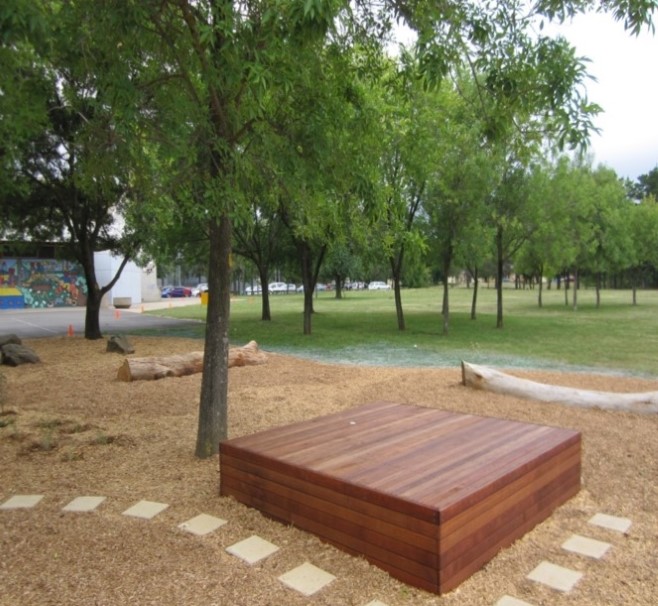Why are school grounds important?
Students spend up to a quarter of the day in the playground and surrounding grounds. If planned well, they can enhance environmental, educational and social outcomes for the entire school community, including:
- lower energy consumption and greenhouse gas emissions
- reduced water use
- a more comfortable playground and improved student behaviour
- better learning outcomes
- protect biodiversity and encourage wildlife.
Use the ideas below to improve your school’s grounds.
Planning school grounds - make a great start
Start by finding out what everyone wants. A survey can gather that information while giving the entire school community a sense of ownership. The ACT Government ACTSmart Schools (formerly the Australian Sustainable Schools Initiative (AuSSI) ACT) has a school grounds community survey which asks participants what they like and dislike about the current grounds and what they would like to see in them.
When planning, take into account the various ‘zones’ within a school such as the public entry, street frontage, assembly area, play and socialising area, boundary, services, special function and out-of–bounds areas. Consider the grounds as a whole and ensure all projects are integrated.

Community surveys led to a new landscaped play area at Giralang Primary which focussed on natural elements and native plants under existing shade trees.
Planting to reduce temperatures
Recent studies have found that vegetation is the most effective way to reduce the surface temperatures of buildings and adjacent areas.
- Trees can intercept up to 90% of direct heat from buildings.
- In terms of evaporative cooling, a single isolated tree is functionally equivalent to five single-room air conditioners running 20 hours a day.
In these ways, landscaping can provide relief from the heat for students, increasing health and comfort. This translates into more physical activity and better thinking and concentration.
For buildings, plantings can significantly reduce building running costs in summer, producing typical air conditioning savings of 25-50%, and up to 80% for some buildings. In winter, trees can reduce heating costs by reducing wind speeds. (Reference: Landscapes for Learning, Australian Institute of Landscape Architects, 2010)
Planting to reduce water consumption
Landscaping can be effective in reducing water consumption in a number of ways.
- Planting a windbreak on northern and western boundaries can prevent hot summer winds drying out the soil.
- Selecting plants with low water needs saves water.
- Covering soil with soft mulch reduces evaporation and adds nutrients to the soil.
The ‘Household” section of the ACTSmart website (www.actsmart.act.gov.au) has a Canberra Plant Selector, Water Right Garden Webtool and a number of fact sheets to help.
Count the social benefits
School grounds can impact positively on children’s physical and mental wellbeing and enhance both the opportunity for and the quality of social interactions. According to the Learning Through Landscapes Trust (UK), landscape design can reduce the incidence of bullying, and reducing hidden areas can assist in the management of student behaviour.
High quality landscaping also increases involvement by parents and the community. First impressions are important and the entrance to a school may influence a parent’s decision to enrol their child. Many schools in the ACT have parent ‘Green Teams’ and volunteers tend to stay when hard work is mixed with pleasure.
See the educational benefits
Hands-on experiences are essential to learning. The development of special areas such as sensory gardens, bush food gardens, environmental orienteering courses, water-wise gardens and vegetable gardens provides hands-on experiences for students. School grounds also provide informal, ‘incidental’ learning opportunities for students, like observing ants during lunch time or recess, or noticing that leaves have changed colour.
School grounds are ideal for conducting cross- curriculum activities. For example, students can assess the environmental benefits of appropriate landscape design by comparing the temperature of an internal wall that receives shade in summer with one that is exposed to the sun. The results can be represented visually (e.g. graphs), as a written report (e.g. scientific or newspaper report) or an oral presentation (e.g. at assembly).
Reap the environmental benefits
Simple changes can achieve positive environmental outcomes.
- Strategic planting can reduce energy and water consumption.
- Using a solar powered water pump to aerate a pond can save electricity.
- Selecting outdoor games made from recycled materials, such as Frisbees made from PET bottles, reduces the consumption of non-renewable resources.
- Purchasing recycled items, such as local recycled landscaping products, or wood sourced from sustainable forests can save trees, reduce habitat destruction and lower transport miles.
Attracting wildlife
- Thick shrubs provide nesting sites for small birds and help keep cats out.
- Thick-barked trees provide a habitat for small creatures such as insectswhich in turn attract larger animals.
- Plants such as banksias and grevilleas attract nectar- and seed-eaters while red and yellow flowers attract birds.
School grounds and biodiversity best practice: A guide
Developed by ACTSmart Schools, the guide offers step-by-step actions for creating school grounds based on the principles of sustainability. The guide includes a Community Survey, tips and hints (landscape design, flora, fauna and soils) and an action plan template. Schools can receive ACTSmart Schools accreditation for their efforts.
Contact an ACTSmart Schools officer for help: This email address is being protected from spambots. You need JavaScript enabled to view it. or 6207 6430.
ACTSmart Schools also has a free horticulture service to assess school grounds and provide advice on design and maintenance, plant selection, keeping chickens, composting, saving water, and increasing biodiversity.To book a visit from the horticulturist contact Lara Lloyd: This email address is being protected from spambots. You need JavaScript enabled to view it. or 62051093.
This article appeared in ParentACTion, Term 2, 2014. See other past editions of our quarterly magazine.
